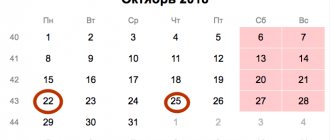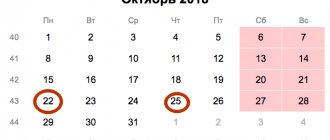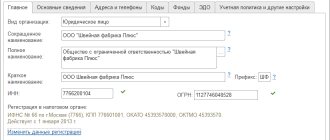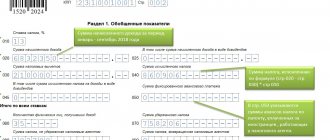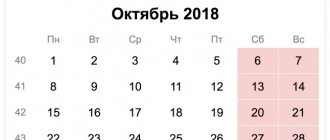Form 4-FSS contains information about contributions “for injuries” and other information related to labor protection. Sometimes situations arise when the activity has not yet begun or has been suspended and, therefore, the businessman does not have the data to fill out the form. Is it necessary to submit a report in this case, and if so, how to do it correctly? How to fill out the 4-FSS zero report for the 3rd quarter of 2021? We will answer your questions and provide a sample of filling out the zero 4-FSS for 9 months of 2021.
Legal grounds and features of filling out the “zero” form 4-FSS
All policyholders must submit Form 4-FSS, i.e. legal entities and individuals who use the services of hired workers.
This is established by paragraph 1 of Art. 24 of the Law of July 24, 1998 No. 125-FZ “On Compulsory Social Insurance...”.
This law does not provide for exemption from the obligation to submit a report in the absence of a basis for calculating contributions. Only individual entrepreneurs without employees do not submit Form 4-FSS. And a legal entity, even if there is no activity, must have at least one employee - a director.
An interesting situation arises if the company does not work, and the director is also the only founder. In this case, he often does not consider it necessary to conclude an employment contract “with himself.” Should such a manager be considered an employee? From the latest clarifications of the Ministry of Labor it follows that (letter dated March 16, 2018 N 17-4/10/B-1846). Officials refer to Art. 16 of the Labor Code of the Russian Federation and indicate that labor relations arise upon the actual admission of an employee to work, regardless of the existence of an employment contract with him.
Therefore, legal entities are required to submit a report to 4-FSS in any case.
To determine the composition and procedure for filling out the “zero” form, you need to refer to the order of the Federal Tax Service of the Russian Federation dated September 26, 2016 No. 381 (as amended on June 7, 2017). This regulatory act approved the form of the 4-FSS report and the procedure for filling it out (hereinafter referred to as the Procedure).
Form 4-FSS for 9 months of 2021 can be downloaded here.
If there is no activity, it is not necessary to submit all sheets of the report. The composition of the “zero” 4-FSS can be limited to four mandatory sections listed in paragraph 2 of the Procedure:
- A title page containing general information about the policyholder.
- Table 1, including the basis for calculating contributions.
- Table 2, dedicated to settlements between the policyholder and the Social Insurance Fund branch.
- Table 5, which contains information about the special assessment of working conditions (SOUT) and mandatory medical examinations.
Next, we will consider how to fill out these sections of the 4-FSS zero report. A sample form can be downloaded here.
Zero reporting
Sometimes an organization or individual entrepreneur does not have the data to fill out tax and other reporting. This happens if no activity is carried out and wages are not accrued or paid. This happens when an organization:
- reorganization;
- liquidation;
- suspension of activities by authorized bodies;
- economic difficulties.
Or the new company has not yet started its activities, but the reporting deadline has already arrived. There are reports that are submitted and in the absence of activity and data in them, they are called zero. It is impossible to say unambiguously whether it is necessary to submit zero reports to the Pension Fund and the Social Insurance Fund - it all depends on the status of the employer and the type of report. Submitting 4-FSS in the absence of payments to employees is mandatory if the employer is registered as an insurer with the Social Insurance Fund. There are no exceptions in the absence of information to fill out by law.
Use free instructions from ConsultantPlus experts to correctly fill out and submit Form 4-FSS on time.
to read.
Form 4-FSS is required for all policyholders. Let's figure out whether it is necessary to submit a zero report to Social Insurance if there are no payroll accruals in the reporting quarter. Yes, the report must be submitted in any case, with some exceptions. But even if insurance premiums were not calculated or paid during the reporting period, a report must be sent to the territorial body of the Social Insurance Fund within the prescribed period. This applies to both organizations and some individual entrepreneurs.
Title page
This section contains information about the policyholder. The order in which it is completed does not depend on whether the report is null or not.
- Registration number - assigned to the policyholder at the Social Insurance Fund office upon initial registration.
- The subordination code indicates the division of the fund where the policyholder is currently registered.
- The adjustment number shows how many changes were made to the report. For the initial version, the code “000” is used, then “001”, “002”, etc.
- The “Reporting period” field consists of two parts. The left one contains information about the period for which the form is submitted. For 9 months it is “09”. The right side of the field is used if the report submitter is requesting funds to pay an insurance claim. In this case, the number of requests is indicated - from 01 to 10.
- Calendar year is 2021.
- The letter “L” is entered in the “Cessation of activity” field only if the policyholder is liquidated and the report is submitted in accordance with clause 15 of Article 22.1 of Law No. 125-FZ. If the activity is actually suspended, but the liquidation procedure has not officially begun, then this field does not need to be filled in.
- In the “Full name/full name” field, information about the organization or individual is indicated, based on the relevant documents (constituent or identity documents).
- TIN and KPP codes (the second code is only for legal entities) are filled in on the basis of a certificate issued by the Federal Tax Service. Because An individual’s TIN is “longer” by 2 digits, then organizations enter zeros in the first two cells of the field.
- The “OGRN/ORGNIP” field contains the number of a legal entity or entrepreneur assigned during state registration. For organizations, the first two cells of the field, similar to the TIN, must be filled in with zeros.
- The “OKVED Code” field is filled in based on the OK 029-2014 classifier (NACE Rev. 2). If the policyholder has been working for more than a year, then the code must be confirmed by the Social Insurance Fund, taking into account the class of professional risk (Order of the Ministry of Health and Social Development of the Russian Federation dated January 31, 2006 No. 55).
- The “Budget organization” field is used only by businessmen who receive funding from the budget depending on its level:
– federal – “1”;
– regional – “2”;
– local – “3”;
– receipts from several budgets – “4”
- Contact phone number of the person responsible for providing the form.
- Fields reflecting the total number of personnel, the number of disabled people and those workers who work in harmful / dangerous conditions are filled in in accordance with the requirements of Rosstat (order No. 772 dated November 22, 2017).
- Information on the number of sheets of the report itself and supporting documents (if any).
- Confirmation of the accuracy of the report includes information about the responsible person, his signature, the date the report was compiled and the seal. If the report is submitted by a representative, then you must also indicate the details of the power of attorney.
- Upon receipt of the report, the fund employee indicates the form of submission, the number of sheets, the date of acceptance, his full name and signature.
Table 1 “Calculation of the base for calculating insurance premiums
This section of the report provides information on payments to individuals and the amount of the insurance tariff.
Because We are talking about a zero form, then lines 1 – 4, which reflect the base for calculating contributions, must be filled in with dashes.
But lines 5 – 7, which show information about the insurance tariff, also contain indicators when generating a “zero” report. Even if the organization is not currently operating, it still belongs to a certain field of activity, which corresponds to a specific tariff.
- The specified tariff taking into account the class of insurance risk is given in line 5.
- Lines 6 and 7 are filled in if the FSS has established discounts or surcharges on the insurance tariff for the policyholder (Resolution of the Government of the Russian Federation dated May 30, 2012 No. 524).
- If a premium was provided, then in line 8 you need to indicate the date of the FSS order that established it.
- Line 9 contains the final “variant” of the tariff, taking into account all adjustments (in percentage, with two decimal places).
The procedure for filling out the “zero”
It just seems that since there are no indicators, then you don’t need to fill out anything except the header. Let's consider how to submit a zero declaration to the Social Insurance Fund, what and where to fill out in it. The accountant should know in which fields and cells:
- put dashes;
- enter zeros;
- leave empty space;
- indicate the indicators (they are also in the zero level).
The title page of the zero report has no special features and is filled out as usual. Please note that when filling out the TIN field, zeros are entered in the first two cells if the TIN consists of 10 digits. A similar rule is provided for filling out the OGRN if it consists of 13 digits: there are 15 fields for the code, so we put zeros in the first two cells.
All fields, columns and cells in which there is no data to be filled in should be filled with dashes. But putting dashes in all calculation fields is unacceptable. Some strings have numeric values:
- In table No. 1, line 5, we indicate the insurance rate for insurance against accidents and occupational diseases assigned to the organization. This field cannot be left empty.
- In table No. 1, line 9, we indicate the result of arithmetic operations with the values of the basic tariff, allowances and benefits. If an organization applies an increased or decreased tariff, you will have to provide data in additional reporting lines.
- In Table No. 2, we indicate in the provided lines the amounts of outstanding debt or overpayments for past reporting periods.
In zero reporting, display information on payments for debt on insurance premiums for past quarters (reporting periods).
If the organization has not ceased to operate, then the “Cessation of activities” field is left empty. We do the same with the “Budgetary organization” field if the company does not have such status. This cell can only be filled out by representatives of the public sector.
Table 5 “Information on the special assessment of working conditions and medical examinations”
Table 5 in the zero report may also contain information if the policyholder has previously conducted business. The fact is that it shows information at the beginning of the year, i.e. based on the results of previous periods.
Line 1 reflects information about the special assessment of working conditions (SOUT):
- Column 3 shows the total number of jobs.
- Column 4 shows the number of jobs for which an assessment was carried out at the beginning of 2021.
- Columns 5 and 6 show the number of assessed workplaces with harmful (class 3) and dangerous (class 4) working conditions.
Instead of SOUT, the employer can indicate the results of workplace certification if its validity has not yet expired as of January 1, 2018 (Article 27 of Law No. 426-FZ of December 28, 2013 “On SOUT”).
Line 2 contains information (also at the beginning of the year) about mandatory medical examinations of workers who work in harmful or dangerous conditions.
- Column 7 reflects the total number of such employees subject to medical examination.
- Column 8 indicates how many of them actually passed the medical examination.
The procedure for submitting a zero report 4-FSS and sanctions for violation
Form 4-FSS must be provided in accordance with the requirements of Art. 24 of Law No. 125-FZ. The submission procedure does not depend on whether the report contains the amount of accrued contributions or not.
Here, only the number of insured persons plays a role. Small companies can submit the form on paper if they have no more than 25 employees.
If the number of insured persons exceeds 25 people, then the employer is obliged to submit the report electronically.
“On paper” in the form of 4-FSS must be submitted by the 20th day of the month following the reporting period, and in electronic form - no later than the 25th. Those. the 4-FSS report for 9 months of 2021 must be sent before October 22, 2018 “on paper” (due to the postponement due to weekends) and before October 25, 2018 – in electronic form.
Sanctions for violation of the deadlines for submitting the 4-FSS report are established by Art. 26.30 of Law No. 125-FZ.
In this case, the fact that the report is “zero” affects the size of the fine. Its amount depends on the length of the delay and the contributions accrued according to the report. And because the zero report “by default” does not contain accrued amounts, then for any delay a minimum fine is applied - 1000 rubles.
An employer may also be punished if he submits a report “on paper” without having the right to do so. Then the fine will be 200 rubles.
Officials may be additionally fined in the amount of 300 to 500 rubles. according to Art. 15.33 Code of Administrative Offences.
But in this case it is impossible to block the policyholder’s accounts. In paragraph 3 of Art. 76 of the Tax Code of the Russian Federation deals with tax returns, and form 4-FSS does not apply to them (letter of the Ministry of Finance of the Russian Federation dated 04/21/2017 N 03-02-07/2/24123).
When it is not necessary to pass zero
Article 346.52 of the Tax Code of the Russian Federation regulates who takes the 4-FSS. This obligation is separately defined for individual entrepreneurs who are employers and registered with the Fund. If an individual entrepreneur has employees, he needs to report. But is it necessary to submit 4-FSS for individual entrepreneurs without employees? No, these entrepreneurs are not registered with the Social Insurance Fund as insurers. They do not pay wages and report on insurance premiums. The same rule applies to entrepreneurs using the patent tax system, even if they have employees. Individual entrepreneurs do not bear responsibility for failure to pass the zero level.
